Museums and Exhibitions in New York City and Vicinity
| Home | | Museum Guide | | International | | Architecture and Design | | Theater |
GLENN LONEY'S MUSEUM NOTES
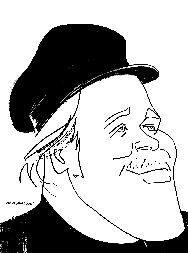 |
| Caricature of Glenn Loney by Sam Norkin. |
CONTENTS, October 2003
[01] Dahesh Museum and Academic Art
in the IBM Bldg
[02] "Crossing the Channel" at the Met Museum
[03] Winthrop's "Private Passion" Here from Harvard
[04] Boucher Drawings at the Frick Collection
[05] Italian Manuscript Paintings in Lehman Wing of Met
[06] Blockbuster EL GRECO at the Met
[07] Oribe Ceramics and Arts of 16th Century Japan
[08] Daguerreotypes and "The Dawn of Photography"
[09] American Indian Art at the Met
10] American Museum Opens "PETRA: Lost City of Stone"
[11] New Arthur Ross Hall of Meteorites at AmMusNatHist
[12] "Sonic Vision" at Rose Center, plus Music Mixed
by MOBY
[13] "Hunt for Paradise," Persian Court Art at Asia
Society
[14] An Explosion Event: "Light Cycle Over Central Park"
[15] Manhattan Philanthropy: "Near East/New York" at
Museum of City of New York
[16] Thomas Jeckyll at Bard Grad Center
[17] MARIMEKKO at Bard
[18] Viennese
Silver at Neue Galerie
[19] "Schoenberg, Kandinsky, and the Blue Rider" at
Jewish Museum
[20] "Body and Soul: Expressionism and Human Figure"
at St. Etienne
[21] Berlin Holocaust Memorial on Lamp-posts
[22] Frida Kahlo's Intimate Family Picture
[23] "Prokofiev and Contemporaries" at Lincoln Center
Library
[24] Rosenquist Retrospective at Guggenheim
[25] Jay DeFeo's "Rose" at the Whitney
[26] "Housing in Vienna/Architecture for Everyone" at
Austrian Forum
[27] "Reversed Double Helix" at Rockefeller Center
[28] George Segal's Works on Paper at CUNY Grad Center
[29] World Monument Fund's 100 Most Endangered Sites
[30] Beethoven/Berlioz" and The National Music Museum
You can use your browser's "find" function to skip to articles on any of these topics instead of scrolling down. Click the "FIND" button or drop down the "EDIT" menu and choose "FIND."
For editorial and commercial uses of the Glenn Loney INFOTOGRAPHY/ArtsArchive of international photo-images, contact THE EVERETT COLLECTION, 104 West 27th Street, NYC 10010. Phone: 212-255-8610/FAX: 212-255-8612.
Copyright © 2003Glenn Loney.
For a collection of Glenn Loney's previous columns, click here.
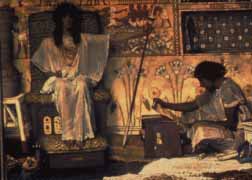 |
| RELIGIOUS HISTORICISM AT THE DAHESH--Sir Lawrence Alma Tadema's Academic Art: "Joseph, Overseer of Pharaoh's Graneries" Photo: Courtesy Dahesh Museum |
Academic Art Comes To the IBM Building:
The Admirable Dahesh Museum of Art
Opens Major Venue for Salon Masterpieces!
[Permanent Exhibitions, with French Artists in Rome closing November 2, 2003]
For some seasons now, the Dahesh Museum has had to show some major works of Academic and Salon Art in a very small second-story space on Fifth Avenue. The location was certainly midtown, but the museum had almost no street-visibility. And the available exhibition walls were limited and low, so that showing important large paintings and sculptures was difficult. Often, Dahesh shows had to be based on smaller works, even on mere studies for paintings too large for the confined spaces.
That did not prevent the Dahesh's curators from mounting some very impressive exhibitions, featuring notable masters of the academic tradition from the 19th and early 20th centuries. The interest these shows sparked in many viewers—especially younger visitors who had grown up with Modernism and Abstract Expressionism—demonstrated that there is a great public interest in the masterly techniques and the grand historical, religious, and mythological subjects of French, British, and German painters and sculptors who worked in these traditions.
Certainly the Metropolitan Museum of Art has large and very important holdings of Academic and Salon Art, but—with so many ages and areas of arts to showcase—great salon paintings have been largely restricted to the long second-floor corridor flanking Impressionists and Moderns and leading to major touring shows. Rosa Bonheur's "The Horse Fair" was an occasional attraction, as viewers scurried by to see the latest Blockbuster Show in the rear galleries. But the Dahesh was and is dedicated to the exposition, explanation, celebration, and study of Academic Art, long vilified by Modernists.
Searching for a larger venue, the Dahesh Museum made a bid for the Edward Durrell Stone-designed Columbus Circle Art-Gallery, created for the late Huntington Hartford. Your reporter even wrote a letter on its behalf to the Landmarks Commission. The Dahesh also applied for the wonderfully restored Tweed Courthouse—now being recycled as a series of inner-city schoolrooms, a shameful waste of such magnificent spaces.
But the Final Solution for the Dahesh has proved even more impressive and inviting than either of those potential venues. The Dahesh now occupies the three floor-levels of the former IBM Galleries at Madison Avenue and 57th Street. When IBM was forced to cut back on its public presence in the Arts—in a time of dire financial circumstances—New Yorkers, especially the thousands who work midtown, lost a wonderful place to meet and admire artworks from many countries and cultures. You could have lunch in the great atrium of the IBM Building, hear a brief noontime concert, go downstairs to the IBM Galleries to enjoy some superlative artworks, and be back in the office all on your lunch-hour!
The newly installed Dahesh Museum is profiting immensely from this convenience of location and confluence of viewer-needs and interests. It could not be more central, especially compared with the Met's location way up on Fifth Avenue. Not to overlook the closure of the nearby Museum of Modern Art for its epic reconformation.
The Dahesh is now so handy, so visitor-friendly, that it is becoming the midtown Museum of Choice. It not only has its own attractive cafe, but it also has a stunning new Museum Shop whose colorfully displayed wares brighten the street-level panorama on Madison.
What is more, it is almost always crowded with busy New Yorkers and avid arts-tourists, and not just at the lunch-hour. On several recent visits—at various times of day—I found it difficult to get close to some fascinating major paintings, so intent were others on minute observation of the details of the various artists' imagery, composition, and painterly techniques.
At MoMA and the Whitney, you can easily stroll by large canvases by Frank Stella and other Modern Ikons without pausing. Take in the Moderns on the run! But at the Dahesh, you really have to take time to study the paintings and the sculptures. Few moderns have even made the effort to master the techniques of the Salon artists—although there are some notable contemporary exceptions who have demonstrated brilliant painterly skills in service of quite different visions than those of Academicians who were fascinated by "Sir Galahad", "Salome with the Head of John the Baptist", or the "Rape of the Sabine Women."
In the Modern Era, the preferred subjects of the 19th century Salons of Paris and of London's Royal Academy often became objects of derision or downright despair. Neo-Classicism, Historicism, and Romanticism had had their Day. Many museums either put their huge Academic canvases in basement storage or disposed of them. But times and interests are constantly changing, and interest in such masterpieces as the Dahesh has in its extensive collections are again coming into their own.
The current exhibition, French Artists in Rome: Ingres To Degas, 1803-1873, is especially impressive and instructive. While American painters went to Paris to study in the late 19th century, brilliant European talents had been going off to Rome, notably outstanding young French painters. A number of them studied at the Villa Medici—home in Rome of the French Academy—soaking up and visualizing on canvas or in stone and bronze the magnificent majesty of classical, Renaissance, and Baroque Rome, its art and architecture, its history and culture.
Among these greats were Ingres—both a pensionnaire and later director of the Villa Medici, David, and Flandrin. Degas, Corot, and Moreau were not pensionnaires, but they came to Rome for the same reasons: artistic exposure to its eternal influences. So they won places in this show, even if they didn't win the prix de Rome in their own youths.
This is the only North American presentation of this powerful show, organized by the French Academy in Rome, on the occasion of its bicentennial. Loans come not only from major French museums, but also from major US collections such as the Met, the National Gallery, and the Cleveland Museum of Art.
The Academic Adapts to the IBM Mandate
The distinguished architect Hugh Hardy designed the transformation of the three levels of the Dahesh Museum. The initial problem was to adapt spaces in a relentlessly Modernist high-rise block of black glass to the service—and even greater glory—of handsome display of major works of Academic Art, on the surface rather at odds with the building itself.Hardy makes the point that Modernism—and by extension, even Edward Larrabee Barnes' monolithic IBM Building—grew out of its Academic predecessor. These growing-pains were often very painful, indeed frequently vindictive, so this was not a gracious transformation in the artworld of the late 19th century. Hardy's transformation of the interior spaces is much more successful, making the Salon at home in the Skyscraper.
As a fellow-member of the Municipal Art Society of New York, I must confess a great admiration for Hugh Hardy's considerable abilities as an architect. As a Nominator for the Society's annual Brendan Gill Prize, I chose Hardy as a candidate for his masterful restoration of David Belasco's 1900 Victory Theatre on 42nd Street's Theatre Block. Hardy's ingenious preservation of the historical exterior and interior—with state-of-the-art adaptations for contemporary performances—have made the New Victory Theatre a major US venue for outstanding theatre productions designed to appeal to both children and their parents. And the winner of the Gill Prize was of course Hugh Hardy!
Perhaps Hardy will get another award this season for his transformation of the old IBM Galleries into the new Dahesh Museum?
Academic and Salon Art at the Metropolitan--
"Crossing the Channel:"
British and French Painting
In the Age of Romanticism
[Closing January 4, 2004] This autumn, Salon and Academic painting come into their own at the Met once again. This wide-ranging exhibition of major—and some minor—canvases is rewarding in many cases for the magnificence of the artists' visions of people, passions, and places. But the artful arrangements of subjects, the painterly skills in line and color, the ingenious rendering of details of costume and gesture, of objects and nature: these all call attention to the essentials of academic painting.
But this show also documents the shift of salon artists from the Neo-Classic and Historicism into the new Romanticism which developed following the final defeat of Napoleon and the subsequent Congress of Vienna. The Romantic Movement was exemplified in literature by Goethe, but was made visually manifest in major Salon paintings. Even more than that, however, this exhibition focuses on the interactions among French and British artists working in similar traditions. This show makes a special point of the influence some British innovations had on French painters: this was not a one-way channel-crossing.
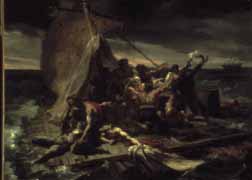 |
| SEA SURVIVAL
SAGA--Géricault's "The Raft of the Medusa," French Romantic
Masterpiece on loan to the Met. Photo: Courtesy Metropolitan Museum. |
The entrance to this show is dominated by an immense full-scale copy of Géricault's "The Raft of the Medusa". This sepia-toned canvas of the survivors of a disastrous shipwreck is from Amiens, as the original is in the Louvre.
In contrast to the historical paintings of David and the religious and mythological compositions of earlier academic artists, the strong portraits, sensuous landscapes, genre scenes, and even notable animal paintings in this show exemplify the changes which Romanticism was encouraging.
There are 150 works on view at the Met, a number of them probably familiar to art-lovers and students. Among the French and British painters: Constable, Turner, Delacroix, and of course Géricault. Also featured isthe English ex-pat artist, Richard Parkes Bonington, who provided Parisians with a link to British developments in Romantic sensibilities in art.
A Private Passion:
19th Century Paintings and Drawings
From the Grenville Winthrop Collection, Harvard
[Closing January 25, 2004]
This show is even larger than "Crossing the Channel"—some 200-plus artworks—but Academic and Salon paintings and sculpture are central. So it makes a wonderful complement to the first exhibition. An Extension, and more, for Winthrop collected American artists and others not working in academic confines. William Blake is certainly outside the world of the Salon.
Grenville L. Winthrop was fortunately so wealthy that he could devote most of his life to amassing his considerable collections. They are now at Harvard University, this exhibition being the first time his masterworks have toured. Oddly enough, I had just seen this show in London at the National Gallery, so it was interesting to see it redeployed in the chambers of the Iris and B. Gerald Cantor [think Cantor-Fitzgerald] Exhibition Hall.
 |
| PRE-RAPHAELITE
BEAUTY--Dante Rossetti's "The Blessed Damoze"l. Photo: Courtesy Fogg Museum, Harvard University. |
Some of Winthrop's canvases are more impressive than some in the Channel show. Among his favorites—for which he must have paid top-dollar at the time—are Ingres, Delacroix, David, Burne-Jones, Homer, Géricault, Rossetti, Singer Sargent, Whistler, Moreau, Pissarro, Rodin, and Renoir. This is a Visual Feast. If you like the Pre-Raphaelites, you may merely admire Winthrop's Burne-Jones visions, but you will surely love Rossetti's "The Blessed Damozel."
Famed French Artist at the Frick:
The Drawings of François Boucher
[Closing December 14, 2003]
This handsome show celebrates Boucher's 300th birthday in a way that might have delighted him. For the first time, it brings together a variety of his drawings of a wide range of subjects. Here are landscapes, pastorals, portrait sketches, visions of religious, historical, and mythological figures and scenes, as well as symbols of allegory and literary images, plus contemporary 18th century moments.
There are some 75 sheets—on loan from major collections—in the intimate downstairs galleries of the Frick and the small chamber by the museum shop. Among the images are an unfinished scene from Molière and an architectural sketch for a baroque monument.
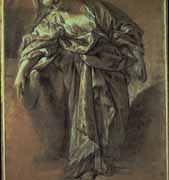 |
|
MASTER DRAFTSMANSHIP--François
Boucher's "Despondent Woman" Drawing at the FrickPhoto:
Courtesy the Frick Collection. |
There is a world of difference between Boucher's simple Recumbent Female Nude and his complex Landscape with the Aqueduct at Arcueil. In a different visual vein, the contrasts between Head of a River God in Profile and Study of a" Despondent Woman" in Drapery are also fascinating.
What this beautiful show especially underlines is Boucher's remarkable talent as a draftsman in capturing human qualities, as well as those of nature and architecture.
Earlier Art-History at the Met Museum:
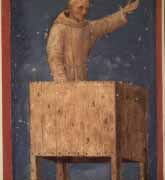 |
| NOW HEAR THIS!--Italian illuminated manuscript image of Saint Bernardino Preaching. Photo: Courtesy Metropolitan Museum. |
Treasures of a Lost Art:
Italian Manuscript Painting
Of the Middle Age and Renaissance
[Closing February 1, 2004]
Robert Lehman was fortunate that he did not have to earn his living digging ditches or teaching school. Had he done so, he would never have been able to amass the art treasures he willed to the Metropolitan Museum. With enough millions left over to recreate at the rear of the Met some noble chambers of the Lehman Mansion on Fifth Avenue. These serve as showcases for his painting, sculptures, wood-carvings, tapestries, ceramics, silver, crystal, enamels, and other objects. Met visitors—as in Mr. Morgan's Library-office—can thus play the plutocrat and imagine themselves enjoying such masterpieces in the privacy of their own—temporarily borrowed—home.
One of Lehman's collecting-passions was acquiring rare Italian illuminated manuscripts. Or large and handsomely illustrated initials cut from much larger vellum pages. An unfortunate consequence of the demand of rich—but often art-ignorant—19th century collectors for beautiful but small images was the hacking of illuminated initials with intricate miniatures from great pages of choir-books, called Antiphonals and Graduals.
Neither these voracious collectors nor their eager art-dealers realized how much more impressive, meaningful, and valuable these miniatures would be when preserved in paginal-contexts. Fortunately, some of the finest medieval miniatures ever painted—in France, Germany, and Spain, as well as in Italy—were illuminations of pages in very small missals or Books of Hours. The pages were already the size of some choral-book initials: no need to cut them down further.
Lehman's collection, originally some 145 images, was primarily composed of pages or initials from choir-books, rather than pages of breviaries and such small sheets. The current Met show has 99 single leaves and two bound volumes of illuminations. These are drawn from the Met's own holdings, the Yale University Art Gallery, and a private collector. Each of Lehman's magnificent illuminations is worthy of close study for its various beauties and details of almost microscopic painting techniques. But there is a much larger overview in this show, documenting changes in images from the late Medieval Period to the High Renaissance in Italy. The progression from the flat visions in the style of Giotto to the perspective renderings of the Renaissance gradually unfolds as the viewer progresses through the exhibition.
Lehman's illuminated pages were created for choir-books in churches of Siena, Florence, Ferrara, Parma, Venice, and other cities in Tuscany, Lombardy, and the Veneto. Some of the images are being shown for the first time; some are from little-known masters of the Italian miniature. Among the Masters: Duccio, Lorenzo Monaco, Belbello da Pavia, Stefano da Verona, Cosimo Tura, and Franco dei Russi.
These illuminated images are wonderfully wrought, but they are small and the basement illumination in the Lehman Wing is very low, to protect the manuscripts. So you may want to give yourself enough time to study each one carefully, using the magnifying glasses the Met provides. Your eyes, your imagination, and your spirit will be richly rewarded!
Having taken a class at the Morgan Library in gold-leafing on vellum and hand-made paper surfaces, I now have some faint idea of the varied technical skills these great artists of small pictures had to develop. But the visions, the figures, the landscapes, the architectures they imagined: those were not entirely matters of craft, tradition, and convention—which is why the styles and perspectives—if not the subject-matter—changed over three Italian centuries.
The Morgan—with its priceless collection of illuminated manuscripts—is to be closed for renovations until 2006. So you may want to hurry over to the Met to get as much illumination as you can.
| COLDLY
CLERICAL MAJESTY--El Greco's magisterial portrait of A Cardinal. Photo: Courtesy Metropolitan Museum. |
This Season's Fine-Arts Blockbuster at the Met:
EL GRECO, Landmark Retrospective of
The Monumental Mannerist and Pre-Modernist
[Closing January 11, 2004]
The word Landmark may have been overworked in recent museum-hype of Blockbuster Shows. But it surely applies to the Met's El Greco Retrospective. This is such a stunning and comprehensive show of the great Greek Master's Masterpieces that many will want to see it again and again. Despite the density of the crowds which now throng the galleries.
Many of El Greco's major canvases are here, on loan from major museums worldwide. Of course there's one of his "Views of Toledo", but also a favorite from my student years at UC/Berkeley, the "Saint John the Baptist" from the M. H. DeYoung Museum in San Francisco. I grew up with that affecting image in mind. Not to overlook a painting of similar subdued style, "Saint Martin and the Beggar," which later became my favorite at the National Gallery in Washington.
Although El Greco's elongated figures, tormented expressions, and flamboyant use of color set him far apart from other masters of his day, he was seen as a Mannerist, if a very wild one. In fact, despite the admiration of later great Spanish painters, his reputation languished until he began to be re-discovered as the First Modernist. Or at least the grandfather of Modernism:
Early influences of Byzantine religious art were clear in his first important paintings in Venice and Rome, but, until recently—with the discovery of ikons he had actually painted in Crete—it was not known how direct they were. His studies of Italian styles and traditions helped to form him, but he found his own very distinctive vision in Spain, in Toledo.
Many of El Greco's paintings are necessarily of religious subjects, considering his patrons and commissions. But there are also some powerful portraits, among them Saint Louis, King of France, with a Page. And that forbidding "Cardinal", a Met-owned masterpiece.
There are some 70 El Greco artworks in this retrospective, including two figures he fashioned of polychromed wood. Though small-scale, these may provoke some thoughts about what might have been, had he pursued sculpture as well as painting.
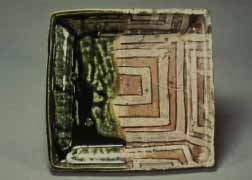 |
| MODERN
DESIGN FROM 16th CENTURY JAPAN--An Oribe ceramic now on view at the Met. Photo: Courtesy Metropolitan Museum. |
At the Asia Society:
TURNING POINT:
Oribe and the Arts of 16th Century Japan
[Closing January 11, 2004]
Late 16th century Japan was a time of tremendous turmoil—the Momoyama Period—but it was also cauldron of change in the arts and in society. This new Met exhibition is the first in the West to document aspects of that change. It focuses on Oribe ceramics, made for the traditional tea-ceremony, and demonstrative of dramatic changes in shapes, decorations, and colors from earlier, more conventional, wares.
Some similar ceramics have been shown at the Asia Society, but this is a show in context, so painted screens, lacquerware, kimonos, and fabrics are included to show their relationship to the daring changes in Oribe ceramics.
Oribe is not a Japanese locale but the name of the ceramics-master, Furuta Oribe, born around 1543. Surviving examples of his work show strangely mis-shapen vessels, suggesting his fondness for accidentally warped or damaged clay-objects. But his innovations were not only in terms of shapes. He experimented with colors and glazes, as well as surfaces on objects.
There are some 200 ceramics, paintings, textiles, and lacquer objects in this show. The delicacy of some lacquer screen and box decorations make a strong contrast to the deliberate roughness of some Oribe ceramics.
Also at the Met:
The Dawn of Photography:
French Daguerreotypes, 1839-1855
[Closing January 4, 2004] Light-levels are necessarily low for this show of very early photos. Louis Daguerre's discovery of the process of making an accurate pictorial record from life onto a prepared copper sheet was rapidly to create both a new industry of photography and a new art-form. The latter development was not, however, immediately recognized or honored at such.
Today, even test-shots and pictures Daguerre and his contemporaries took of trees, houses, and quite ordinary people have become important pictorial artifacts, testimonies to a vanished time—which was actually not so long ago… There are 175 of these images in the Met show.
This fascinating exhibition not only reveals details of the faces and fashions of Parisians ands Frenchman of the mid-19th century. But it also heralds—even with its technical limitations—the photographic innovations which were soon to follow. At the same time, it examines the fertile artistic soil out of which Daguerre's discovery sprouted. Daguerre was initially a Romantic painter, a print-maker, and a painter and proprietor of the Diorama, featuring large-scale panoramic paintings of scenes and views under changing illuminations.
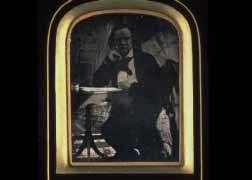 |
| FIRST
PORTRAIT PHOTOGRAPHS--Daguerreotype of famed French author Victor Hugo. Photo: Courtesy Metropolitan Museum. |
Views of the Paris of Daguerre's day are now priceless, as are Daguerreotype portraits of such mid-century French Greats, as Victor Hugo, Alexandre Dumas, Eugène Delacroix, and Jean-François Millet. In fact, even the distinctive embossed cardboard and velvet cases for the plates are now collectors' items, even without an exposed plate in the center. If you find one, with an image or not, snap it up.
Way back in 1950, I found my own mother throwing vintage Daguerreotypes—the fad had caught on in the Victorian United States very fast—into the wastebasket. The images must have been ancestors, but no one had thought to write names on the backs of the frames. Not knowing who these gray-bearded men and tightly-corseted women may have been, Mother was "not going to hold on to them any longer." I salvaged some, but over the years, they seem to have disappeared…
At last, On Native Grounds at the Met:
The Responsive Eye:
Ralph Coe and Collecting of American Indian Art
[Closing December 14, 2004] Collector and curator Ralph Coe began acquiring objects of American Indian ritual, tradition, and daily-life with a totem-pole he found in Manhattan in a Third Avenue shop. That was in 1955, and he has been adding to this find ever since, creating a very wide-ranging assortment of arts and artifacts from tribes from the Northwest Coast to the Plains Indians, tribes of the Southwest, and some very special artifacts from Indians of the Northeast. This show displays 200 of Coe's often remarkable acquisitions.
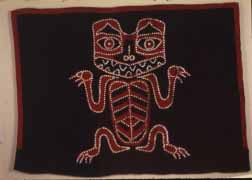 |
| NORTHWEST
COAST BUTTON BLANKET--Haida artwork from Ralph Coe Collection. Photo: Courtesy Metropolitan Museum. |
His eclectic methods have been quite different from those of Phoebe Apperson Hearst, who give UC/Berkeley's Anthro Museum an immense trove of Indian artifacts from California and the Southwest. Berkeley's great patroness—and "Citizen" William Randolph Hearst's doting mother—simply had her agents buy out entire stocks from Indian trading-posts in Arizona and New Mexico.
Mrs. Hearst certainly recognized the importance of such ceramics, baskets, drawings on leather, beadworks, carvings, and textiles as distinctive American artifacts, arts and crafts which might soon die out. She found them decorative, but she did not perceive them as works of art.
That distinction apparently belongs to Ralph Coe, as the Met exhibition credits him with being an ardent champion of the aesthetic merits of American Indian Art, past and present. In this show, it is a bit unsettling to see traditional crafts adapted to very trendy aspects of Pop Culture, but the flip-side is the realization that these indigenous crafts and images are not dying out, but rather surviving and changing with the times.
Diego Romero, of Cochiti Pueblo, has achieved a reputation as a satiric ceramic artist. His Chungo Brothers dough-bowl makes mock of a paleface approach to academic archaeology.
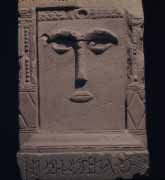 |
| FOUND
AMONG THE RUINS--This stylized face from the Lost Stone City of Petra
looks almost Modern. Photo: Courtesy American Museum of Natural History. |
At the American Museum of Natural History:
PETRA: Lost City of Stone
[Closing July 6, 2004]
This is a most impressive installation, considering how distant and almost inaccessible the site of the great stone treasures on display actually is. Petra is known to many only by versions of that famed photo of what appears to be a Greek temple, carved of solid rock, seen through a narrow cleft in a stone mountain.
But that incredible carved structure is only one of the majestic ruins hewn out of the living rock of the desert cliffs which enclose the remains of this ancient city. From 200 BC to 300 AD, Petra was a crossroads of caravan traffic across the Arabian Peninsula, east and west, north and south. Its people, the Nabateans—who had their own language, written and spoken—lived from the trade-routes and caravans. Some camel-caravans came from Syria or even as far as India.
But the Nabateans got more than food, fabrics, and pots from traders. The ideas, arts, architecture, and beliefs of Greece and Rome also found their ways into this mysterious metropolis near Jordan's Rift Valley. And, in the dry dusty desert, they were able to find water-sources and bring them into their city by specially devised channels.
An earthquake in the Fourth Century AD, however, spelled the end of their civilization. After that, Petra—as in Simon Peter's name, it means Rock—was forgotten over the centuries. It was rediscovered by Johann Burckhardt, the Swiss explorer, in 1812.
In 1937, the Cincinnati Art Museum conducted excavations among the ruins, rubble from the still-standing great edifices in the cliff-walls having buried many sculptures, deities, and decorative details. These were divided between the Museum and Jordan's Archeological Museum in Amman. Now, for the first time since they were uncovered, many of these imposing stone sculptures are at last reunited at the American Museum of Natural History.
Personal Disclosures:
When I visited Petra back in 1958, I saw the great Treasury, the abandoned theatre and the Roman arena, as well as other imposing temple-like rock-carved monuments which I was told were ancient tombs. But I saw nothing like the magnificent heads of Gods or the carved cornices now on view on Central Park West. They had already been pried loose or dug up and hauled off to museums.
In the wake of World War II, Middle Eastern Tourism had begun to thrive, with Egypt's Luxor and Jordan's Petra among the most remote and mysterious of destinations. Luxor was, of course, far easier to reach than Petra. But Brits and Euros who could afford to travel never went there in summer. January was the ideal time to visit Petra: a tent-city would be set up inside the cliffs as a temporary hotel.
Unfortunately, I had only two weeks in the heat of June to explore Egypt and Jordan. There were no tours to Petra in summer. But the sister of the Anglican Bishop of Jerusalem—I was staying at the Archbishop's Palace, thanks to American friends in Sa'udi Arabia—arranged for a taxi to take me and a Scottish lady from Basra to Petra for $30 each. It is a two-day journey, there and back, so the price was right.
Just outside Jerusalem, after we'd left the Damascus Gate, the taxi stopped and a German student stepped out from a bush. He proved to be a buddy of the driver who wanted to see Petra for free. In fact, he paid for himself with his guided tour, stopping the cab so we could see the oldest mosaic map of Jerusalem on the floor of a tiny church out in the desert. He also pointed out Crusader castles.
We reached the outer cliffs of Petra at nightfall. The local police let us sleep on wooden cots with ropes for support—no bedding—in the one-room station. They slept outside on the ground, as snakes slithered under our beds.
At sunrise, we mounted mules and rode through that pictorially famous and very narrow cleft in the cliffs. On our left loomed the immense Treasury, but our Arab guides hurried us up endless stone steps to the top of the mountain above. As the sun rose, we were standing around a great square stone altar with a flat surface flanked by stone ridges. I imagined blood sacrifices on this altar at sunrise a thousand years ago.
The Petra valley is very long, most of which we traversed on foot. Despite its dryness, even in June the oleander were in bloom. They thrive in the desert—also in my native California. At the end of the day, I and my Scottish friend were dying of thirst. The Arabs had long since disappeared with our mules and waterbags. When we finally straggled out through the towering cleft, we found our mules. And the Arabs—who were grinning broadly, as they had drunk all our water!
Some years after this adventure, some Nabatean tombs were found in northern Sa'udi Arabia. I had long wanted to return to Arabia—where I had taught for two semesters—to see how things had changed in the Eastern Province. And to see the tombs. I was paid up in full for just such a trip, departing October 2001. Even after 9/ll, I was still willing to go—most had canceled long before—but I got a note that the Sa'udi Government could not guarantee the safety of Americans in their country.
Petra, however, is still a possibility. Tourism has been developing in Jordan, with Petra a major destination. You won't have to sleep over slithering snakes anymore, but you do not want to go there in June.
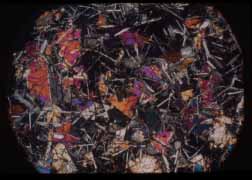 |
| LOOKING
DEEP INTO METEORIC FRAGMENTS--Colorful patterns of mineral structures. Photo: Courtesy American Museum of Natural History. |
Also at the AmMusNatHist:
The Arthur Ross Hall of Meteorites
[Permanent Installation]
This hall is not on the scale of some other geological installations at the American Museum, but it is a valuable complement to them. In fact, it seems a rather small cylindrical space, crammed with actual meteorites and displays. When all the press and the TV camera-crews got inside it at the press-preview one could hardly move, let along study the exhibits and their instructive texts. It features a very impressive model of the great Arizona Meteorite Crater, used by NASA to train the Moon-shot Astronauts.
Displays include more than 130 meteorite specimens, fragments of the fragments of comets, asteroids, and planets which have fallen to earth. The centerpiece of the Ross Hall is the great Ahnighito fragment, the "LARGEST METEORITE ON DISPLAY AT ANY MUSEUM IN THE WORLD."
Disco-Evenings at the American Museum:
Sonic Vision and Music Mixed by MOBY
In the Rose Center for Earth and Space
With Hayden Planetarium No-Stars Laser-Show!
[Specific Evenings Until Further Notice] It is of course thrilling to explore the Outer Reaches of Space with the great laser-show in the Hayden Planetarium. And to realize that Earth is less than a speck of dust in the All. It is even frightening to learn that the Universe is constantly expanding, and at an ever-increasing rate.
Fortunately, thanks to an ingenious and totally trendy new laser-show, the American Museum's evening Planetarium visitors will be attending at an ever-increasing rate as well. This intriguing show of rapidly moving and morphing images, called Sonic Vision, interweaves dreamworld images with music to give the effect of indoor recreational smoking, without the actual pot.
The music has been mixed by Moby—who was present at the press-launch, to introduce the experience to his eager fans. Moby's choices include David Byrne and Brian Eno, White Zombie, Prodigy, White Queens of the Stone Age, Coldplay, and Stereolab.
Before and after the shows—38-minutes each seating—there was socializing, snacking, drinking, and dancing on various levels of the Rose Center for Earth and Space. Overhead hung the great spheres of the planets. This could become a great weekend Singles Mixer Event. It could alter that old Burlesque joke: "Meet me at the Pawnshop [Rose Center], daddy, and I'll kiss you under the balls."
 |
| PERSIAN
MINIATURE PORTRAIT--Treasure from Safavid Court in Old Persia. Photo: Courtesy Asia Society. |
Old Persia at the Asia Society:
Hunt For Paradise: Court Arts of Iran, 1501-1576
[Closing January 18, 2004]
If you have been studying Islamic Beliefs—especially in the wake of 9/11—you may have discovered that the original Ten Commandments are seriously honored, especially the one about not making any Graven Images. Consumption of alcohol and pork are also forbidden. Whatever the beneficial effects on the diet such rules may have, the ban on representations of birds, animals, and humans has had a predictably restrictive effect on the arts of strongly traditional Muslim lands. Calligraphies and geometric patterns have provided the only outlet for pious artists for centuries.
How then to explain the creation of those marvelous Persian miniatures, featuring rich rulers with their courts, or on the chase, or in battle? It must have been a matter of religious interpretation, at least in the Golden Age of the Safavid Dynasty in what is now Iran. [In modern Iran, however, all those photographs of various ferocious Ayatollahs are now explained away as not being graven images and, therefore, not subject to the Divine Commandment,]
In the new show at the Asia Society, there are a number of very intricate and beautiful illuminations of scenes from court life, as well as poetry, history, and legend. At least two of these small but powerful illustrations have elements of distinctly Chinese pictorial traditions. The highly stylized clouds would not look out of place on a scroll-painting or a screen. And the eyes of the courtiers and other people have a slant to them that is not a Persian characteristic. But only the eyes suggest Chinese in Shah's clothing.
The reason for this, apparently, is that the Persian Safavid Shahs were so appreciative of arts and crafts that they attracted masters from all over Asia to their courts in Tabriz and Herat. But not only painters came at the call: also weavers, ceramicists, and metal-smiths.
Among the 75 precious objects on display at the Asia Society is one of only three surviving Persian carpets from the 16th century. This immense and intricate weaving is on loan from Milan. In fact, the entire exhibition will next be shown in Milan at the Palazzo Reale and the Museo Poldi Pezzoli.
Textiles, calligraphy, wood-carvings, ceramics and even some pierced metal staff-standards—gold inlaid on steel—are on view.
Also at the Asia Society:
An Explosion Event:
Light Cycle Over Central Park
China's innovative Cai Guo-Qiang has been playing with fire, or at least fireworks, for over twenty years. In China, Japan, and now the United States, where he lives, he has been creating artworks by exploding fireworks in patterns on prepared papers with some symbolic drawings on them. He also designed a special fireworks show over Central Park for its 150th Anniversary on September 15. This of course was not done on prepared paper, but there certainly were paper preparations for the show. The gunpowder-scorched patterns on the large sheets on the gallery walls of the Society are certainly suggestive. Although the various explosive packages are set on the base-papers in general symbolic patterns, the way each firework explodes provides an unexpected, unprepared, unpredictable individual powder-pattern.
The gallery's brochure describes Cai Guo-Qiang as an "important artist." This must be so, as he is accorded plaudits in the press, and this project attracted financial support from the Andy Warhol Foundation, among others. But then, this is exactly the kind of intellectualized fun-thing Andy would have loved…
At the Museum of the City of New York:
Near East/New York:
Near East Foundation and American Philanthropy
[Closing December 7, 2003] December 7th is Pearl Harbor Day. Is there any special significance in choosing this date for closure of a salute to American solicitude for unfortunates abroad? Probably not, for the Near East Relief was initially concerned with saving a generation of Armenians, persecuted by the Ottoman Turks.
Hitler's Holocaust was not the first, nor the only, Genocide in the 20th Century. Thousands and thousands of Armenians were slaughtered or driven into the deserts to starve to death early in the last century. This show provides a timely reminder—almost a century later—of what needs to be done when a defenseless people is attacked by a much stronger power.
Horrified by reports of the atrocities of Turkish soldiers against the Armenians—who had no nation of their own, nor any nation they could turn to for protection—influential and wealthy New Yorkers banded together to provide immediate aid. Not only were food and clothing forthcoming, but medical supplies and treatment as well. Orphanages were established for children whose parents had been slain or starved to death.
Arts and crafts of Armenia were preserved and encouraged so that traditional clothing and artifacts made by Armenian women and children could be sold in American shops and charitable centers. Publications, posters, and public meetings spread the message of the humanitarian efforts and how they could be supported.
Cleveland H. Dodge was central to the creation Near East Relief, initially called the American Committee for Armenian and Syrian Relief. Inspired by Henry Morgenthau—then Ambassador to the Ottoman Empire—Dodge rallied a number of New York's Movers and Shakers to work with him. His fortune was based on the Phelps-Dodge mining industries in the American West. [In fact, Phelps-Dodge is still operating important copper mines in Arizona.]
This is a small-scale show in the museum's basement. It consists largely of documents, including important and informative letters, publications, and photos. But there are some arresting posters rallying support for the Armenian children, as well as other campaigns. Such as aid for ethnic peoples in Syria, Lebanon, Palestine, and Egypt.
From its 1915 founding to 1930, Near East Relief raised $1.25 billion in today's dollars for over a million refugees, whose lives were thus saved. Today, as the Near East Foundation, it continues to work in the Middle East and in Africa. Decades before the US Agency for International Development—or AID—appeared on the international scene with similar programs, the Foundation had long established the policy of working at the grassroots level, helping people to help themselves.
Thanks to the Near East Foundation, generations of American children have been reminded to "Clear Your Plate—Remember the Starving Children in Armenia!"
Shattered Iraq now seems an ideal and additional proving-ground for the Foundation's programs. But should we also send all the broccoli we won't eat to Baghdad? Remember, President Bush's father, ex-President Bush, famously said he didn't have to eat broccoli anymore now he was in the White House. But then Presidents don't have to clean their plates: they let the taxpayers do it for them…
The Big Difference today, of course, is that the Americans had not attacked the Armenians they sought to help. The same cannot be said about Iraq, so perhaps there is an even greater Humanitarian Debt to be paid?
At the Bard Graduate Center:
Thomas Jeckyll: Architect and Designer
[Closing October 19, 2003] One of the Bard Center's most fascinating shows—but, in fact, there have been many of these—is its exploration of the Neo-Gothic/Aesthetic career of Thomas Jeckyll. Initially, this brilliant draftsman and architect made a name for himself in restorations of historic buildings, from the Gothic to Queen Anne. Building on this experience—in which he often integrated modern, more useful and practical, elements in his historical preservation efforts—he began to draw on older styles in designing entirely new buildings and interiors.
Coming to London from Norfolk, he was fortunate to enter the charmed circles of the Aesthetic Movement, of which Oscar Wilde was perhaps the most visible exponent. This led Jeckyll to adapt Japanese motifs and constructions for British clients, in the process developing a distinctive decorative style. Furniture he designed for his interiors has this in depth. He also designed mass-produced cast and wrought ironwork. The Norfolk factory of Barnard, Bishop, and Barnards produced most of these, including the monumental 1862 Norwich Gates, which sparked an English revival of interest in cast and wrought-iron.
One of the most remarkable displays in the Bard show documents the imposing cast and wrought-iron Pavilion Jeckyll designed for B, B and B at the Philadelphia Centennial Exposition. This magnificent structure was shown elsewhere to great acclaim. But it returned at last to Norwich, where it grew shabbier and shabbier, through civic and citizen neglect and abuse. Until at last it was demolished. To study the designs and photos—as well as some surviving elements—of this remarkable building is to deeply regret that it was not saved and restored. But there was no English Heritage at that time, and Norfolk was hardly a storm-center of tourism or artistic-sensibility.
MARIMEKKO:
Fabrics, Fashion, Architecture
[Closing February 15, 2004] The Bard Center is opening this exhibition in late November, when your reporter will be looking at quite different designs in India. So this note is just a reminder to check out Bard's survey of the development of this stunning Finnish design brand from 1951 to the present.
Those who wear Marimekko clothes, use its stunning decorative fabrics, or have entire Marimekko interiors will know what to expect: bold designs in equally bold colors. For those unfortunate few who think Marimekko is a Japanese brand, this show may be a revelation. The name designer Armi Ratia chose for what was originally a textile-printing company combines the Finnish word for Mary with a Karelian dialect-word for dress: Mekko.
Ratia's genius in launching Marimekko was to invite young Finnish artists to try out their design ideas, no holds barred, and free of traditional ideas about patterns, fabrics, or cuts and silhouettes of garments. The results have been stunning artistically, and globally successful with eager customers.
Bard showcases some 150 fabrics, photos, clothing, accessories, and Marimekko architecture in this exhibition, curated by Marianne Aav, of the Finnish Museum of Art and Design.
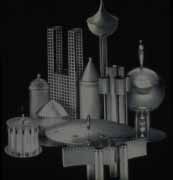 |
| CITYSCAPE OF VIENNESE
SILVER--Photo-collage of Wiener Werkstätte objects at the Neue Galerie. Photo: Courtesy Neue Galerie. |
At the Neue Galerie:
VIENNESE SILVER:
Modern Design, 1780-1919
[Closing February 16, 2004]
In the beautifully restored Fifth Avenue mansion which is now the home of the Neue Galerie, the entire third floor is now devoted to splendid examples of Viennese silverwork. If it seems odd to begin a "Modern" survey in 1780, there is an historical reason.
Not only does the handsome Hapsburg Court tea-service on display—commissioned by Empress Maria Theresa—show a progression away from the intricacies of Baroque design. But the photograph of Emperor Joseph II's simple leaden sarcophagus-standing alone in front of the elaborately baroque tomb of the Empress and her Consort in Vienna's Kapuzinergrüft—also heralds a new interest in simplicity and objectivity. This was to be developed simply and handsomely during the Biedermeier Period, in silver objects and cutlery, as well as in furniture, ceramics, and glassware.
This movement toward simplicity and elegance was to reach its artistic height at the Jahrhundertwende of the 19th and 20th centuries. The designs of Otto Wagner, Josef Hoffmann, and Koloman Moser—in silver and in much else as well—even today seem as Modern as anything being designed now. On view at the Neue Galerie are some treasures from the Wiener Werkstätte, founded by Moser and Hoffmann. Here is a lovely jewelry-box Gustav Mahler gave to his wife Alma [Schindler-Mahler-Gropius-Werfel: the Life she led!].
Also on view are silver objects once owned by the Wittgenstein Family and a silver box of Emilie Flöge, Gustav Klimt's friend and muse. In addition to this marvelous silver, there are a number of important Klimt paintings—as well as watercolors by Egon Schiele—from the permanent collection displayed in interiors which would have been considered splendidly modern in Turn of the Century Vienna.
On the ground-floor, looking out on Fifth Avenue, you can enjoy the experience—and the liquid and pastry treats—of a stylish Viennese Coffee-house. This is Café Sabarsky, which also offers racks of daily newspapers, from Vienna's Der Standard to Manhattan's Times, for its patrons to enjoy while taking a break from business, shopping, or culture.
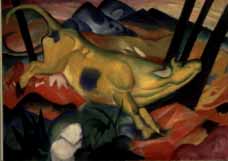 |
|
THIS COW DIDN'T
JUMP OVER THE MOON--Franz Marc's
"Yellow Cow", shown in "Schoenberg, Kandinsky, and the
Blue Rider." |
At the Jewish Museum:
Schoenberg, Kandinsky, and the Blue Rider
[Closing February 12, 2004]
Even before Arnold Schoenberg had discovered/devised Twelve-Tone musical composition, he had tried his hand at painting. On the evidence of various self-portraits and other Schoenberg subjects in the current exhibition at the Jewish Museum, he might well have had a modest career among the Expressionists. Those who have never been able to comprehend his more difficult compositions may well wish he had not left the brush for the keyboard.
Thanks to an interesting innovation in museum audio-guides, however, visitors to this show will be able to study the drawings, paintings, photos, scores, letters, and other documents in a musical context of the turbulent times in Central Europe from pre-World War I Vienna, Berlin, and Munich. To hear the music of Mahler and Schoenberg, against the often bland commentaries of curators, is to wish for even more Schoenberg.
It may come as a surprise to lovers of modern music that Arnold Schoenberg was so deeply involved with modern movements in other arts as well. His friendship with—and admiration for—the wildly colorful Expressionist Russian painter Wassily Kandinsky is richly documented in this show, with publications and illustrations. Schoenberg's artwork was, in fact, included in a Blue Rider art-exhibition.
At this time, Kandinsky was living in the Rus Haus in Murnau with his painter-lover, Gabriele Münter. Bavarian locals gave the house this name, disapproving of an unmarried couple in their Roman Catholic midst—and a Russian at that! They also had an apartment in Munich, but the Murnau cottage was the center of their lives and work. Many paintings of this time, both by Kandinsky and Münter, show views of the old city of Murnau—near Oberammergau—as seen from their home. Münter favored views from her upstairs bedroom. Kandinsky painted their wooden staircase with bold Russian images, and they are still there to be studied by visitors to the Münter House, now a municipal museum. In the late 1950s—when I was actually teaching in Murnau—I was able to visit the house when it was just as Münter had left it—left it to her by then aged housekeeper.
For me, the saddest—and possibly the most humanly important—aspect of this thoughtful and colorful exhibition is the exchange of letters between Schoenberg and Kandinsky, when the composer had heard gossip that his old friend and artist-colleague Kandinsky was an anti-semite. His bitter letter, rejecting an important post suggested by Kandinsky, indicates that—although he had converted to Christianity early in the century—he had suddenly discovered that he was not thought of as a Protestant, a German, or even, perhaps, as an artist. With the rabble-rousing rise of Adolf Hitler, already in 1923, Arnold Schoenberg had discovered that what he was essentially was only a Jew.
It is said that the intriguing and insidious Alma Mahler had spread the rumor that Kandinsky was anti-semitic. Kandinsky wrote a letter of strenuous protest to Schoenberg, but the damage was definitively done. These artists met once again, much later, but the early respect and friendship was gone. Especially affecting is Schoenberg's comment to Kandinsky that the painter was a different man in their earlier years, and of his hope that future generations would be able to overcome racist attitudes.
Another sad note is the triangle of Schoenberg, his wife Mathilde, and his friend, the young Viennese painter Richard Gerstl. Mathilde left Schoenberg for Gerstl, only returning when she was almost shamed into doing so for the sake of their children. Shortly after, the brilliant and promising Gerstl committed suicide.
Fortunately, the brilliant colors of a number of canvases by Kandinsky, Münter, Franz Marc, August Macke, and Alexi von Jawlensky will cheer you up immensely in the midst of the political, social, and spiritual turmoils of these times. My favorite is Yellow Cow of Franz Marc, on loan from the Guggenheim—which also has one of the largest Kandinsky collections. Marc's almost Cubist/Structuralist The Wolves (Balkan War) is also a potent composition of colors, but far less bucolic. It was also prophetic, as Marc was killed early in World War I.
At Galerie St. Etienne:
BODY and SOUL:
Expressionism and the Human Figure
[Closing January 3, 2004] This small-scale show at Galerie St. Etienne provides a perhaps unintentional pendant to the Blue Rider exhibition at the Jewish Museum. Unlike many of the canvases in the Kandinsky/Schoenberg show, however, these drawings, watercolors, and paintings are limited to depictions of the human figure or face. A specific connection between the two exhibitions is St. Etienne's self-portrait of Richard Gerstl.
Austrian artists well known to Kandinsky and Schoenberg are also in this show: Oskar Kokoshka—once a lover of Alma Mahler—and Emil Nolde, whose portrait heads at the Neue Galerie are so arresting. Nolde was, however, obsessed with drawing and painting female genitalia, which is off-putting to many admirers of German/Austrian Expressionism.
Other artists represented include the Usual Expressionist Suspects: Otto Dix, Max Beckmann, Ernst Ludwig Kirchner, Paul Klee, George Grosz, and Käthe Kollwitz—a favorite at Galerie St. Etienne.
If you are not able to check out this show, at least request a copy of the three-section brochure, especially for its very informative essay on the essence of Expressionism. I assume this was written by Jane Kallir, heir of the gallery's founder, Otto Kallir, for her previous brochure-essays have all proved most useful sources of background and documentation of the arts of Mittel Europa in Modern Times.
Also on View at Jewish Museum:
Holocaust Memorial on Lamp-posts!
Signs From Berlin: Project by Stih and Schnock
[Closing January 4, 2004] In Berlin, the endless haggling over when, where, and how to memorialize the Holocaust is coming to its conclusion. It would be totally tasteless to call this resolution to the ongoing debates a Final Solution. But at last scores of great blocks of stone are being set on end in rows between what will soon be the new American Embassy and the new high-rises of Potsdamer Platz.
Even as this project was getting underway, financing was still a problem. But one method to encourage donations almost had a counter-effect. Leah Rosch got the idea to create a color-poster of a romantic, peaceful panoramic Alpine Scene. Spread across this vision were the German words: "Den Holocaust hat es nie gegeben."
A huge banner—enlarged from this poster-image—was hung near the Brandenburg Gate on the new Embassy's site. It was also reproduced on two-page spreads of major Berlin newspapers. Unfortunately, it sent entirely the Wrong Message, as most people did not read the fine-print. In very small type, readers were advised that donations were needed to complete the Holocaust Memorial. This, in its turn, would prevent Germans from uttering the much larger-type message. This was: "There Never Was a Holocaust." Rosch had been concerned that a number of Berliners—especially younger ones who had not experienced the Nazi Years—could believe such a message.
Now, at the Jewish Museum, there is an interesting display of a much more ingenious and practical Holocaust Memorial, created at low-cost for a formerly Jewish district of Berlin. When its Jewish residents, shop-keepers, and artisans were expelled after Hitler's Rise To Power, the often handsome apartments and houses were rapidly taken over by Nazi bigwigs. At the war's close, in revenge, the quarter was badly damaged.
Today, it lives again, its houses and apartment-blocks restored. But on various lampposts and signposts there are now signs which recycle various anti-semitic Nazi rulings from 1933 to 1942, when Jews were en-masse deported to the Death Camps. The decrees are printed on one side of these signs with a simple symbol on the other suggesting the significance of the specific Nazi order.
At the Jewish Museum, a video takes viewers on a tour of the sector and its signs. Two large backlit maps show where the signs are deployed in this area of Berlin, along with the decrees and documentary explanations.
Frida Kahlo's Intimate Family Picture
[Closing January 4, 2004]With renewed interest in the brilliant but tormented Mexican artist, Frida Kahlo—thanks to the impressive film-bio of Julie Taymor—the intimate artistic exploration of Kahlo's Jewish, German/Hungarian, Spanish, and Mexican ancestry at the Jewish Museum is sure to be worth a visit. The centerpiece is Kahlo's "My Grandparents, My Parents, and I," on loan from MoMA.
Initially inspired by Henri Rousseau's own fantasy biographical painting, Kahlo designed a fanciful Family Tree—with portraits—showing the lines of descent in her family. Also on view are sketches, family-photographs, and other documentary materials. Kahlo's love for her artist/photographer Guillermo Kahlo—an emigré from Baden-Baden—is clearly demonstrated in these materials.
For many years, Kahlo was known—if at all—as that imposing almost-goddess figure in the murals and paintings of her husband, Diego Rivera. These are imposing portraits indeed, but Kahlo's own visions of herself are just as impressive, but in different ways and styles. The long torments she suffered from polio, a terrible accident, and the infidelities of her famous husband are suggested—often by bizarre fantasies and symbols—in some of her drawings and paintings.
Personal Note:
Your reporter used to visit Mexico City and more distant Mayan and Aztec ruins every year. On one expedition, I made a point to photographing Frida Kahlo's very blue Casa Azul, now a museum, as well as Diego Rivera's studio. In San Francisco, years ago I photographed Rivera's imposing mural for the Golden Gate International Exposition of 1939, on Treasure Island. This great but, at that time, forgotten work features a standing figure of Frida Kahlo at its center. Various Aztecs, Henry Ford, Thomas Alva Edison, Adolf Hitler, and Charlie Chaplin also are included in this mid-century Historical Panorama. I also photographed Rivera's small painting at Stern Hall, UC/Berkeley, as well as the mural he and Kahlo painted for the San Francisco Art Institute. This is the work that was condemned by super-patriots for its alleged Communist Influences. They mistook the red Lucky Strike cigarette-label in a workman's pocket for a Red Communist Symbol. It was feared that art-students, merely looking at the mural, might become infected with the malign virus of Atheistic Godless Communism.
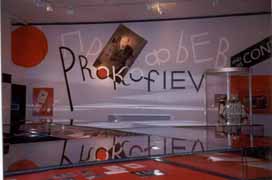 |
| SOVIET
CONSTRUCTIVISM AT LINCOLN CENTER--Revolutionary Russian art-styles used
for installation of Prokofiev and His Contemporaries. Photo: ©Glenn Loney 2003. |
At the NYPL for the Performing Arts:
Prokoviev and His Contemporaries:
The Impact of Soviet Culture
[Closing January 10, 2004]
Sergei Prokofiev had his own problems with Communist Dogma and Orthodoxy. And much closer to the its center than Diego Rivera in San Francisco. With a brutal, ruthless peasant-bred dictator as the sole arbiter of Socialist Arts, how could it be otherwise? What is so ironic and tragic is that both he and his brilliant colleague, Dmitri Shostakovich, were in the vanguard of Soviet Artists inspired by the Revolution and eager to explore new paths and modes in the arts, bringing them closer to the People, the Workers.
The handsomely designed and installed new show at the NYPL's Lincoln Center Library for the Performing Arts surveys Prokofiev's career, in tandem with his interactions with both the Soviet State and fellow-artists. He was fortunate to be able to travel abroad to further his music, and this had an influence on later works. But the Lincoln Center show also documents influences of his instrumental works and productions of his creations for musical- and dance-theatres on American cultural life as well.
For those not keeping score, among Prokofiev's masterpieces for the theatre and concert-hall are "Peter and the Wolf," "The Love for Three Oranges," "Romeo and Juliet," and "The Prodigal Son."
But this show is not just about Prokofiev's impact on American arts and performance. The American tours of the Moscow Art Theatre and Stanislavsky-Dantchenko's Musical Theatre Workshop are duly noted. Nor should the influence of the revolutionary Constructivist/Suprematist stage-designs of such innovators as Alexandra Exter and Mikhail Larianov be overlooked.
The Lincoln Center show includes photos, designs, film-sequences, and recordings. Russian music and films of this era are also part of the program-package.
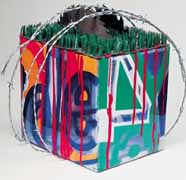 |
| SWIMMER
IN THE ECONO-MIST--Detail of panoramic James Rosenquist painting at the
Guggenheim. Photo: Courtesy Guggenheim Museum. |
At the Guggenheim:
"JAMES ROSENQUIST: A Retrospective"
[Closing January 25, 2004]Early in his career as a painter, James Rosenquist was painting billboards. That experience/training has obviously stood him in good stead as "Master of the Monster Mural." The centerpiece of his exciting, powerful, and colorful retrospective at the Guggenheim is, in fact, the huge three-section mural-work he has created for the Deutsche Bank, sponsor of the Berlin Guggenheim on Unter den Linden.
Titled Swimmer in the Econo-mist, it is a swirling Pop Art collaging of major events and symbols of the Twentieth Century, plus images from Popular Culture. Even Picasso's Guernica is ingeniously quoted in this amazingly turbulent context. It suggests that, despite all the sparkling appeals of Consumer Culture, we are swimming through a flood of products, brands, and symbols—with no understanding of where we and our world may be going.
The effect of swirling vortexes appears in a number of Rosenquist canvases. It is something like those strange 18th and 19th century deliberately distorted paintings which pulled themselves back into reality as images only when a silver cylinder or a reflective cone was placed in their centers.
Rosenquist's mastery of the effects of three-dimensional forms in swirling motion on flat planes often makes it seem that soap-boxes and other common artifacts are being sucked into the whirlpools of the canvases and pushed out through the gallery walls behind.
From a distance—if you can back off that far in the Guggenheim Rotunda or in the very narrow ancillary galleries—Rosenquist's images look like enlarged photographs of ads or actual objects, so carefully observed are the details of construction and surface. Up close, however, it is clear that a mere dash of white or yellow, or a deftly-placed fuzz of gray, are enough to make these images look almost super-real from a distance. This must be something Rosenquist mastered when painting billboards…
His conflating of Pop Culture images in F-111 collages tangles of spaghetti, heavy tire-treads, cake-slices, umbrellas, an Air Force fuselage, and a pretty girl under a hair-dryer to make a suggestive comment on our concerns during the Vietnam War. Oddly enough, the shiny silver cone of the hair-dryer seems even more menacing than the Air Force image beside it. This is shown at the Guggenheim on four walls in a specially-constructed room, as it was at Leo Castelli's in 1965.
Smaller canvases of objects are also very impressive. A row of black nails is especially strong. Rosenquist's more recent effect of laying slashes of a facial portrait over an image of a boldly colored flower is dazzling—if at first a bit unsettling. But you are not getting two pictures for the price of one because neither image is entirely there.
Each Rosenquist canvas is like a sudden jolt of energy. These are colorful, bold, exciting. In fact, walking down the Frank Lloyd Wright Rotunda Ramp makes the entire spiraling installation seem to swirl like objects on individual canvases. Looking across a fourth-level ramp at the opposite side provides a colorful panorama of Rosenquist's development as an artist. For once, the Rotunda spiral is the right place to display flat-surface artworks.
Jay DeFeo's "THE ROSE" at the Whitney
[Closing February 29, 2004]Although Jay DeFeo's monumental "The Rose" is the centerpiece of the compact exhibition now on the ground-floor of the Whitney Museum of American Art, it is visually bracketed with works on paper from before and after the years-long creation of the sculpted painting of her abstract Rose. This is the first New York exhibition of DeFeo's artistic visions, fortunately at the Whitney which has the largest public collection of her artworks. This trove of 22 objects includes paintings, drawings, photo-collages, and collaborations with Bay Area artist Wallace Berman.
The Whitney DeFeo Collection does not, however, include the designs Jay made for my UC/Berkeley Directing-Project of Chekhov's The Boor. They did not survive the painting of the set, nor did I then have a camera to photograph the results…
Rather than reprise the Whitney's press-release on this interesting, if small-scale, show, I offer from the New York Museums.com archive this report I made when "The Rose" had briefly returned to Berkeley from its new owner in New York.
Jay DeFeo's Mystical Rose—
On Loan from the Whitney
On the top level of the UC Berkeley Art Museum—a Post-Modernist interior of concrete decks, porches, and promontories jutting out over a vast open space—an odd selection of Bay Area artworks is dominated by an imposing painting/sculpture mounted on a rigid armature of pipe-steel. This is the famous Rose of the late Berkeley painter Jay DeFeo. It weighs over a ton. Originally an almost ethereal starburst abstraction, DeFeo kept adding dabs and gobs of paint to the surface until it eventually was transformed into a three-dimensional artwork of almost menacing significance.
As Catherine Maclay's article in California Monthly [June 1997] noted: "It used up eight years of the life of its creator, seriously harmed her career, and certainly hastened her death.
"When Jay DeFeo, BA '50, MA '51, finally relinquished her hold on it and allowed it to be moved from her San Francisco apartment, a full crew from Bekins Moving and Storage spent seven hours extricating it from the Fillmore Street Victorian.
"After a brief showing at the Pasadena Art Museum, it languished in obscurity for nearly 25 years, walled up at the back of a conference room at the San Francisco Art Institute.
"When DeFeo, ill and broke, tried to sell it, no museum would take it—though at one time 13 major institutions had tried to acquire it."
But Jay DeFeo was seven years dead by the time the Whitney acquired it. In 1996, she began to enjoy some Posthumous Fame, as it appeared on the cover of Art in America and was the centerpiece of the national touring show on The Beat Generation.
In time—despite, or because of, its epic weight—this obsessive act of on-going creation may become The Icon of the Age of the Beats in San Francisco.
As a footnote, I knew Jay long before she became so obsessed with her Rose. At the University of California in Berkeley, we were Class of 1950. But that was not much of a distinction, as 9,000 candidates rose as a group in Edwards Field to receive our BA degrees.
I was set to direct Anton Chekhov's rustic farce, The Bear, as my Senior Directing-Project in California Hall. Jay and her companion, David Wool, had just come over to the Dramatic Art Office and volunteered to design a show. We chose each other.
Jay and David chose Saul Steinberg's style for Chekhov's Russian Burlesque. Jay gave me a small etching, untitled and unsigned, which I still treasure. She had just finished a much larger abstracted etching, but I had no money for art-purchases.
I was fascinated by it, but David warned me: "Don't make a fool of yourself by asking Jay what it is supposed to be!"
But Jay jokingly pre-empted any such philistine enquiries. Studying it with me, Jay smiled faintly, mysteriously: "It's called Desperate Remedies. It's a woman sitting in the back of a bus. Her doctor has just told her she has cancer."
She also told me about the lament of one of her UC art professors, the sculptor Jacques Schnier. His class was making plaster models of works which should later have been cast in bronze. He told the students that young artists really had to find generous patrons and/or lovers to pay for casting all those plaster models. "Jacques said he should give a class in How to be a Mistress or How to be Kept!"
At the Austrian Forum:
Housing in Vienna/
Architecture for Everyone
[Closing December 6, 2003] The towering new Austrian Forum—at 11 East 52nd Street—is an amazing Post-Modernist creation of one of Austria's most imaginative architects, Raimund Abraham. Its unusually fractured concrete and glass façade is one of Manhattan's most impressive architectural innovations. The site was once occupied by a gracious town-house which was too small for the varied activities of what used to be the Austrian Institute.
The current architectural exhibition on view celebrates subsidized housing in Vienna, and it ought to be instructive to the Mayor and the City of New York. At present, some 625 of every thousand residents of Vienna live in subsidized housing! The City of Vienna itself has 220,000 rental apartments in various new and historic complexes.
But the trend now is to pass on tax and other subsidies directly to developers of new low-cost or low-rent complexes for citizens of modest means. Unlike New York City, Vienna is the Paradise of Low-Cost Housing for thousands who live and work in this great metropolis.
The impetus for this kind of municipal housing-program developed as the old Hapsburg Empire was crumbling and Socialists took over Vienna city government. One of the most famous of the new "Red Vienna" projects is the handsome Art Deco Karl Mark Hof—which your reporter has photographed for the INFOTOGRAPHY ArtsArchive.
Among the many new housing projects featured in this exhibition is the Traviatagasse Residential Complex, on which Raimund Abraham collaborated. Especially interesting is the smartly designed Compact City—almost an architectural sculpture. Then there is the 440-foot high Mischek Tower on Leonard-Bernstein-Strasse.
My favorite complex is the ingenious adaptation of the four great drum-shells of disused Gasometers in Simmering/Wien.
Some projects are represented in models mounted on the walls, but most are printed on translucent fabric, suspended from overhead tracks. Thus, plans, texts, and photos can often be viewed from both sides of the surfaces. This is an installation-technique worthy of Abraham's innovative new home for Austrian Life and Culture.
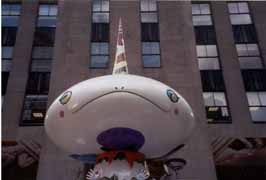 |
| MR. POINTY-HEAD
IN ROCKEFELLER CENTER--Murakami's vision of the Reversed Double Helix. Photo: ©Glenn Loney 2003. |
Seen Around The Town:
Takashi Murakami at Rockefeller Center:
"REVERSED DOUBLE HELIX"
[Closed October 12, 2003]
In recent summers, Rockefeller Center has charmed both citizens and tourists with large-scale arts-installations in the Plaza between Prometheus and Zeus. Jeff Koons' immense floral puppy was a winner, as was a great spread of vintage automobiles all painted silver-gray.
But the biggest spectator-success thus far—especially with small children—has been Takashi Murakami's Reversed Double Helix. This installation—including two immense black balloons spangled with colorful concentric circles—was dominated by the towering figure of Tongari-Kun, or Mr. Pointy-Head. This smiling 7-meter-high giant was flanked by four smaller "guard" figures. On either side of this central display were colorful Mushroom Seats on which hundreds of children played through the summer.
Murakami's art, it's been said, both raises "cuteness" to new highs and pushes it down to new lows. He has been inspired by Charles Schultz's Peanuts, but even more by traditional Japanese two-dimensional painting which ignores Western perspective renderings. He is credited with founding the new Superflat Movement, and his imagery owes much to Otaku, an underground culture of those fascinated by virtual imagery such as the anime of Japanese animated-films.
A Murakami installation was also on view this summer at the Venice Biennale.
At CUNY Graduate Center Gallery:
GEORGE SEGAL: Works on Paper, 1960-1999
[Closing November 8, 2003] For most art-lovers interested in modern sculpture and more especially in modern American artists, the late George Segal's "signature" creations are those white plaster casts of ordinary people, often in evocatively simple environments. In this small-scale but wide-ranging exhibition, however, Segal's interests in drawing, painting, and photography are highlighted. It might even come as a surprise to some that Segal was interested in Abstract Expressionism, even though his plaster people made him seem a Pop artist in that era.
Among the works on display are pastel portraits and portrait etchings, influenced by the lights and shadows of Rembrandt. This attractively mounted show is able to display only a sampling of Segal's varied forms of imagery, but a later exhibition devoted entirely to the pastels could be even more impressive.
Formerly on West 42nd Street, opposite Bryant Park, the CUNY Graduate Center is now located on Fifth Avenue, at 34th Street, in the old B. Altman's Building. The compact gallery is on the ground-floor on the Fifth and 35th Street corner.
The 100 Most Endangered Sites:
World Monument Fund's 2004 List
After the devastating looting and damaging of major museums in Iraq, America's Secretary of Offense/Defense Donald Rumsfeld notably commented: "I didn't know they had that many vases in the whole country." Iraq's ancient cultural heritage was apparently not on the Road To Democracy maps drafted at the Pentagon by Paul Wolfowitz and other Neo-Cons. Of course, no ordinary American Citizen has been permitted to look at those maps, but they must surely show the sites of major oil-fields and caches of Weapons of Mass Destruction? If not Iraq's Museums and Libraries, which now we must rebuild… "You broke it, you pay for it!" But it is not only the Taliban's dynamiting of those immense Buddhas in Afghanistan, or the American bombings of Iraqui sites that have threatened the continued survival of many magnificent historical sites, shrines, and structures around the world. The Forces of Nature are always at work, especially on ancient stone sculptures and buildings. Not to mention those poverty-stricken locals who cannot afford to preserve or restore historic sites, often preferring to make a rupee or two by hacking a God-Head from a centuries-old frieze for resale in London, Paris, or New York.
Fortunately, since its founding in 1965, the World Monuments Fund—to which your reporter is a contributor—has been crossing geographic boundaries, international and regional red-tapes, and various cultural barriers to mobilize protection and preservation of notable works of art and architecture which are under threat of decay, dissolution, or outright disappearance. I have in fact photographed a number of such sites which the Fund has been instrumental in helping save.
One of its most powerful tools in facilitating such preservation and restoration is its World Monuments Watch List of Endangered Sites. Often such listings—and the attendant international publicity and interest—will motivate government officials in Third World, as well as First World, nations to take action.
The famed Ziggurats of Iraq—some see them as mini-models of the fabled Tower of Babel—seem stabilized for the moment. But the famed Iraq ruins of the Palaces of Nimrud and Ninevah, near embattled Mosul, are in dire need of protection. These are among the most ancient survivals of early civilization.
When I was last in Istanbul, I photographed—for the INFOTOGRAPHY ArtsArchive—the remarkable Byzantine Christian murals in St. Saviour in Chorea/Kariye. These had been hidden under stucco for centuries, after this early church had been converted into a Muslim mosque. Fortunately, the Arab armies who overran Constantinople in 1453 did not deface or destroy all evidences of its Christian Past. Some, like the murals, were merely removed from view. On the World Monument Watch's 2004 List is the Kariye Museum!
Also listed is Turkish site of historic Ephesus, ancient city of the Temple of Diana, one of the Seven Wonders of the Ancient World. Some seasons ago, I photographed—also for INFOTOGRAPHY—the ruins of the magnificent Library of Ephesus, as well as the remains of the church where Saint Paul is reputed to have preached. [In the hills high above Ephesus, I also visited the House of the Virgin Mary, where she and St. John took refuge after the Crucifixion. Some Italian Catholics believe the actual house was ferried through the skies to Loretto in Italy by Angels. But the attendants at the site assured me this is the original house. It may be so, as there is a miraculous image of the Blessed Virgin on one wall. It could be an old dried leak, but who really knows about such things?]
In Cambodia's Angkor Thom, I photographed for INFOTOGRAPHY a number of ruined temples, in two of which Monument Fund restoration projects were going forward. Stucco reliefs of Dancing Girls were being restored or replaced. As the great shifting stones of the temples were not restored to their original positions, it struck me that the renovations might still be at risk, both from Nature and hungry locals, looking for souvenir sales.
During the Lisbon World's Fair, I photographed for INFOTOGRAPHY the Jieronimo Monastery which was at the time undergoing preservation, thanks to a Monument Fund initiative. Such listings and preservation-advocacies often serve to motivate local or national governments to move to action, so that the Fund can use its contributions as widely as possible. Important endangered sites can be proposed by concerned individuals or institutions, after which they are inspected by the Fund. There are always far more candidates for the Fund's List than can be accommodated.
Almost fifty years ago, on an epic journey up the Nile, I stopped off in Idfu to photograph the Temple of Horus, which had been buried in Nile mud for centuries. The Fund has an Idfu site on its new list!
When I last photographed the Canal Zone for INFOTOGRAPHY in Panama, it looked as neat as any US Military Reservation. You could see where the Zone ended and Panama City began by the uncut grass and trash on one side. Now the Zone is on the Monument Watch List! Jimmy Carter, you should not have given them the Canal! At least we cut the grass!
In the UK, London's great Battersea Power Station is also listed. I photographed this imposing structure for INFOTOGRAPHY years ago when it was still functioning. And later, when it was only a shell, used at that time as a battle-site for Ian McKellan's proto-Nazi film of Richard III. It had been proposed as yet another of those urban arts-complexes, in order to prevent dynamiting of the shell and the subsequent spread of Condo-Sprawl. But how many arts-complexes does London really need?
Much closer to home, the Watch List includes Frank Lloyd Wright's Ennis Brown House in Los Angeles. When I was Editor of The Modernist, I photographed this beautiful, but threatened, home, as well as all the other Wright projects in Los Angels, including Hollyhock House.
In the 1960s, I lived in Brooklyn Heights, so naturally I photographed historic St. Ann's Church—now also an arts-complex. It is famed for its stained-glass, and it is also on the List.
Even closer yet to home, Historic Lower Manhattan is now on the Watch List! And of course I have photographed its changing fortunes for INFOTOGRAPHY over the years.
If you would like more information on the Watch List and the on-going activities of the World Monuments Fund, or, more important, you would like to become a Contributor, here are some contacts: Phone: 646-424-9594/FAX: 646-424-9593. Plus: wmf@wmf.org and www.wmf.org
Major Music-Instrument Show
In Sioux Falls, South Dakota:
Beethoven and Berlioz/Paris and Vienna
[Closing November 2, 2003] One of the wonders of the worldwide-web is that people actually read some of the millions of reports published in its ethers. This must be the reason your reporter has received two remarkable and beautifully illustrated catalogues from the National Music Museum of the University of South Dakota, in Vermillion, SD.
The Beethoven/Berlioz catalogue celebrates the Museum's current exhibition at the Washington Pavilion, in Sioux City, South Dakota. By the time you read this, however, this impressive show may have closed. But the publication is well worth having—even if you could not see the show—for it documents the musical ferment which reverberated in what the exhibition's sub-title calls The Age of Revolution and Romance.
Not only are the texts by André P. Larson and John Koster illuminating, but the photographs of many rare historic musical-instruments are magnificent. You can study the details of Antonio Stradivari's Choral Mandolino—and its specially constructed case with fleur-de-lys interior decoration. Even the delicate wood-graining and back-designs of Andrea Amati's The King violincello are clearly captured. Simon Spicer and Bill Willroth Sr are the photographers responsible for this impressive archival achievement.
The other catalogue is a Pictorial Souvenir of The Shrine To Music Museum on the Vermillion campus. All the stunning photographs are by Simon Spicer. The museum's amazing world-class collections of important historic music-instruments would be worth a visit to Vermillion in themselves, but, as Spicer's photos colorfully show, the holdings also include American instruments, even the one-man-band of Stan Fritts of the Korn Kobblers. There is also a complete violin workshop on display.
The museum's onsite exhibitions span the ages of music-making and world-cultures as well. A number very important previously private collections form the core of the museum's brilliant assemblage of beautifully crafted instruments. But famous individual instruments have been added to the holdings, thanks to generous donors.
Conservation—as well as display in historical and musical contexts—is also an important function of the museum. As are programs in study of musical-instrument-making and performance on various kinds of instruments. There are currently more than 10,500 instruments in the collection.
As a lure to music-lovers on the Eastern Seaboard, the catalogue gives prominence to one of its major donors' comment: "It's no farther from New York to Vermillion than it is from Vermillion to New York." The museum was recently featured on Public Television in the Great Museums series.
If you are thinking ahead to next summer-vacation, how about a tour of Mid-West Highlights, including Chicago, Milwaukee, Mount Rushmore, and the National Music Museum in Vermillion? In the meantime, you can call the Museum for either or both of its fine catalogues, as well as background information on its collections and activities. Phone: 605-677-5306. Kersten Johnson is the Exhibition Coordinator, and she can be contacted at that number, as well as at FAX: 605-677-6995, or email: kjohns08@usd.edu
[Loney]
Copyright and Copy—Glenn Loney 2003
Copyright © Glenn Loney 2000. No re-publication or broadcast use without proper credit of authorship. Suggested credit line: "Glenn Loney, Curator's Choice." Reproduction rights please contact: jslaff@nymuseums.com.
Return to Curator's Choice Table of Contents